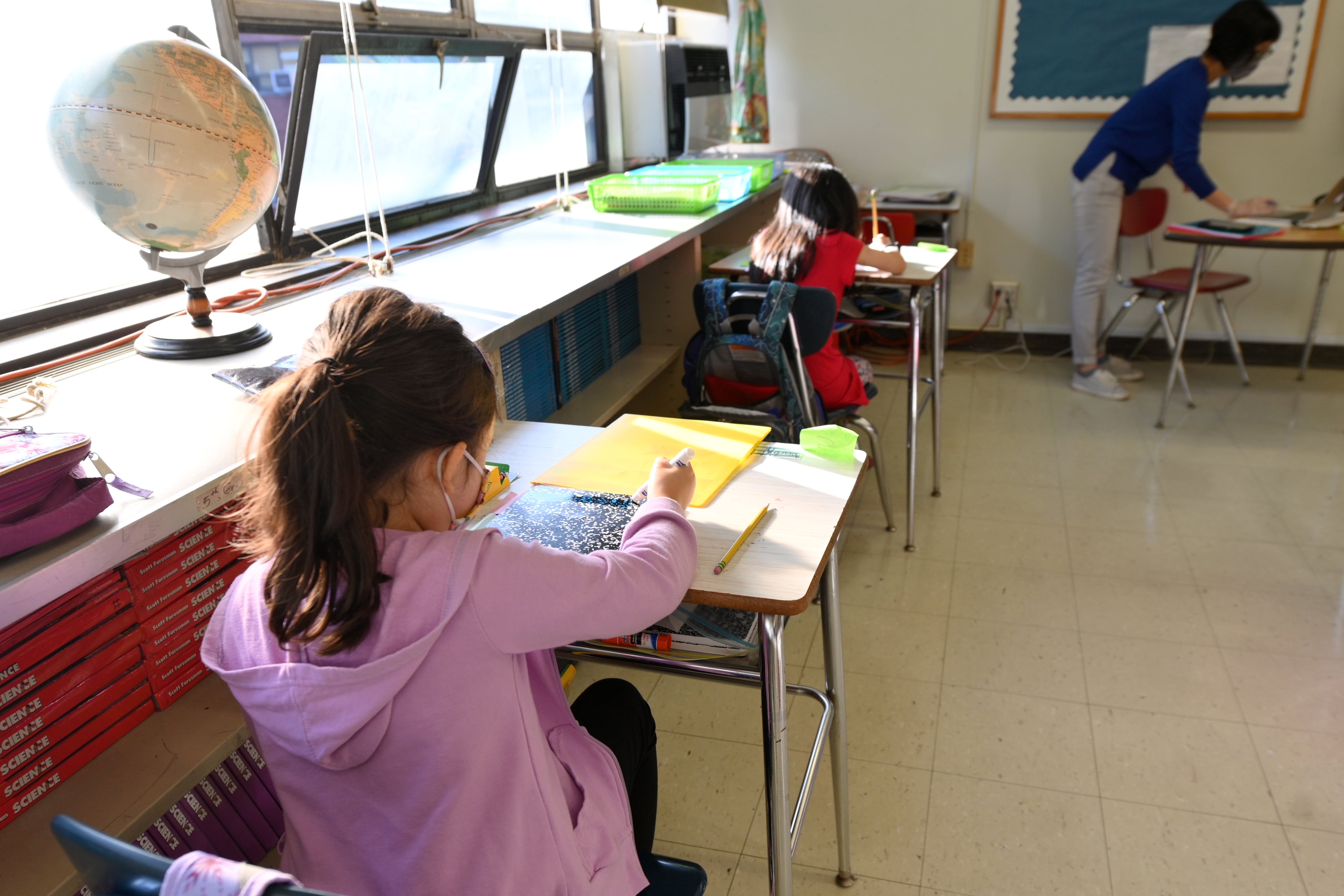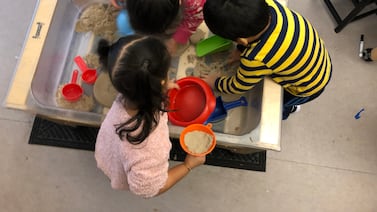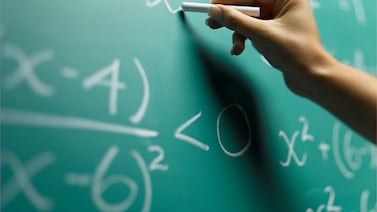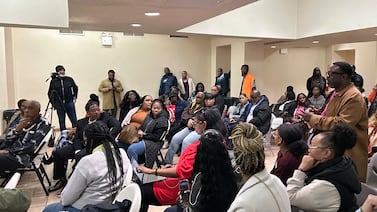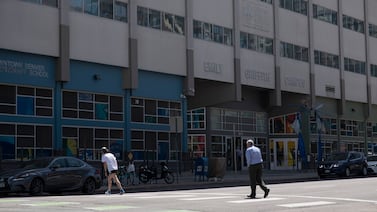When the pandemic disrupted school in the spring, Brandie Gogel did everything she could to keep her students with disabilities on track.
She used YouTube to broadcast music therapy sessions. She made paper packets for students who couldn’t connect to the internet. When summer rolled around, she continued to meet regularly with her elementary schoolers over Zoom, hosting virtual field trips on her own time. Still, parts of their special education plans had to be put on hold. Without being in the same room, some things just weren’t possible.
Now, Gogel is back in her classroom in Polk County, Florida, where schools have been open for two months. Already, she’s seen students’ communication and motor skills getting stronger.
But things haven’t exactly returned to normal. Hugs have become hand symbols. Her students aren’t mixing with students without disabilities during activities like chorus and hallway patrols like they usually would. And since some students are still learning from home, “hide and seek” now involves students turning their iPad video camera off while asking their classmates to guess where they are.
“I can’t wait for everybody to be back,” Gogel said, so everyone can interact in person again. “We’re just making the best of a worst situation.”
In recent weeks, more school districts have reopened for at least some in-person learning, and even some that haven’t are promising to bring students with disabilities back first or for more of the week. For some students with disabilities, that’s meant a welcome return to the routines and instruction that many have gone without or seen reduced since the pandemic began in March.
But with school days shorter in many places, hybrid schedules, and new health and safety restrictions, teachers and students are also realizing that in-person instruction and services have been profoundly affected by the pandemic — raising questions about the potential long-ranging effects on students with disabilities beyond this school year.
“We’re talking about young people for whom every single day of instruction is critically important,” said Temple Lovelace, who directs the special education program at Pittsburgh’s Duquesne University. “Even in these hybrid models, we’re still losing time with kids, and intervention time with them … The loss is compounded on all fronts.”
Many school districts struggled to meet the needs of students with disabilities remotely this spring. In a newly released nationally representative survey of 744 school districts, researchers at the American Institutes for Research found that 82% reported difficulties providing hands-on services, like physical therapy or one-on-one aides, while 61% reported it was harder to provide speech therapy. Some parents of students with disabilities have sued school districts or held protests to demand more in-person support, especially for students with more severe needs.
Now, as more students head back into classrooms, teachers are finding it easier to give students with disabilities what they need and parents say it’s making a real difference, according to interviews with parents and educators of students with disabilities in a half-dozen states.
Michael Galos, a teacher in suburban Minneapolis who works mostly with middle and high schoolers with emotional or behavioral disabilities, has been finding it easier to help students through reading assignments line by line on paper than it was over Google Meet. Even while sitting a few feet apart, he’s picking up better on students’ non-verbal cues.
Robin Vogt, a paraeducator in New Hampshire, says he’s having more success pulling students aside for support in the classroom than he did with a Zoom breakout room.
For Samantha Cortez’s son, a fifth-grader in west suburban Chicago who has attention deficit hyperactivity disorder, in-person school has brought structure and a close bond with the paraprofessional who’s helping him in class.
And Christina Bradburn, a speech language pathologist at a preschool in suburban Indianapolis, has found it easier for students to practice new communication skills when their classmates are nearby. When they can quickly get a response from a peer, it’s “automatic reinforcement.”
Still, some kinds of instruction or services aren’t back to normal. Wearing a mask and working at distance can be especially challenging for students with disabilities who benefit from visual cues or physical touch.
Cortez’s son, for example, is only going to school four days a week, for half a day at a time. Afternoons remain virtual. So even though Cortez sees teachers and staff working hard, she’s “a little bit worried because he might fall behind.”
In other cases, students going into school buildings are finding their services are still being delivered remotely, or the socialization they craved isn’t happening.
In New York City, that’s what happened to Cara Khym’s daughter, an eighth-grader who has Tourette syndrome. She opted for in-person learning in part to see friends, but her class had only a few other students in it and she didn’t know any of them. Her speech therapy was still happening over Zoom.
Her classwork also remained mostly online, and Khym’s daughter, who needs help staying on task, had trouble following along. Khym thought her daughter’s teachers did “superior work” trying to help her, but “it just was not a good fit for her currently during this COVID situation.”
“She was falling behind in so many of the classes,” Khym said. “It just became all very, very overwhelming.”
On top of that, Khym said, her daughter’s tics started to get worse, something that can be brought on by heightened stress. After a few weeks, Khym’s daughter asked to be homeschooled and her mother agreed.
In some cases, COVID restrictions have made it impossible to teach in the same way.
Mollie Minard teaches at a high school in the west suburbs of Chicago and works with students who are on the autism spectrum or have significant needs. A core aspect of her curriculum isn’t possible right now: Trips out into the community to work on life skills.
Usually, her class would spend one to two days each week doing things like learning how to ride the local commuter rail, or shopping for items at Walmart. She’s tried to find alternatives — like teaching them how to order Walmart pickup online — but “it’s been hard,” she said. “They’re missing that.”
Still, in-person instruction and services are making a difference to students like Jennifer Sabourin’s daughter, a kindergartener in Chicago’s west suburbs who has Down syndrome.
When preschool went remote this spring, her daughter, who receives physical, occupational, and speech therapies as well as hearing services, met less frequently with her therapists and teacher and her progress stalled. She spent about 10 minutes a week with each therapist, though her special education plan calls for 30 to 90 minutes a week.
“I understand, but it really wasn’t sufficient for anyone to make any progress,” Sabourin said. “For her to actually be able to get educational benefit from her services she needs to be there, hands-on.”
But since her daughter returned to in-person school in mid-September, her reading, speech, and social skills have improved.
Weighing on many parents and educators is the fear that the in-person instruction and services students with disabilities are receiving now could go away, with COVID cases spiking again in many parts of the country — including in the Illinois county where Sabourin’s daughter goes to school.
Starting this week, her school district will be going remote for at least two weeks, leaving her again with virtual-only instruction and a fraction of the therapy she needs.

